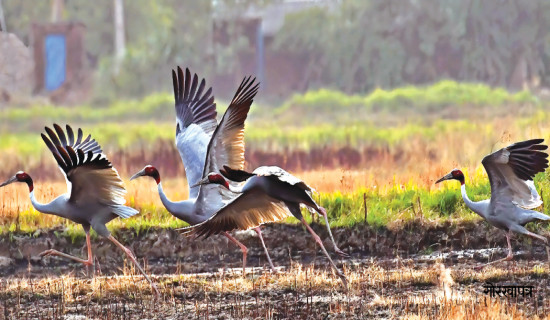- Tuesday, 18 November 2025
Peacock: An Attractive Forest Bird
Rajesh Dhungana
The peacock bird, which is full of beauty, can be seen in the Sauraha of Chitwan National Park, the first national park of Nepal. The peacock is a forest bird. It builds its nest on the ground but lives in a tree. This bird is also called a multicoloured bird. Peacocks are found in different countries of South Asia. During the breeding season, peacocks and peahens are visible in high numbers in the Sauraha forest.
Captivating
A peacock can raise its tail. The shape of which seems to have made it a very captivating display of art. To attract the female peacock, the male peacock spreads its colourful wings and dances around to attract the female peacock.
The breeding season is between April and May when four to five eggs are laid, especially during the rainy season. The eggs are incubated by the female peacock until they hatch after 28 days. When the chicks hatch, they all have feathers and the babies can fly about a week after hatching.

Most blue and green peacocks reach sexual maturity by the age of three.
The scientific name of this bird is Pavo Cristatus. Male peacocks are 195 to 225 cm long, while female peacocks are about 95 cm long. Male peacocks weigh 4 to 6 kg, while female peacocks weigh about 3 to 4 kg. The average age of this bird is about 23 years.
The male peacock's tail is blue with feathers and their backs are shaped like beautiful eyes. The tail of the female peacock is not like this and the body has a mixture of green and grey colour. In Hindu culture, the peacock is considered to be the god of good luck and success.
The two best-known species of peacock are the blue or Indian peacock of Nepal, India and Sri Lanka {Pavo Cristatus) and the green or Japanese peacock (Pavo muticus) found from Myanmar (Burma) to Java. The Congolese peacock (Afropavo congensis), which lives in the jungles of the Congo, was discovered in 1926 after a search began in 1913.
The feathers on the body of the blue female peacock are usually metallic blue-green. The green peacock with a blue train has green and bronze feathers on its body. Peacocks of both species are green and grey.

It is almost as big as a rooster. But the train and the jewellery on my head are lacking. In the forest, both species live in the open lower forest. Shepherds live in trees during the day and at night.
Peacocks do not involve in sexual intercourse in the traditional sense, 'because male peacocks do not have sexual organs.' It is even mentioned in the epic that it treats sperm as a liquid substance but other than that its real peacocks do not have sexual intercourse physically.
However, the male peacock will mount the peahen and align his cloaca — a common orifice for the digestive, reproductive and urinary tracts— with hers to transfer sperm in what is known as a 'cloacal kiss.' It's over in a matter of seconds. The birds part ways, with the male looking for his next partner.
Peacocks prey on grains, plants, flower hypocrites, seed heads, berries, small insects, and lizards. It seeks its food in arable lands, forests, etc.
Neighbouring India declared the peacock a national bird in 1963. It is one of the national symbols of India.
Peacocks are terrestrial feeders. Some studies have even suggested that the complexity of the "speed" produced by the peacock's performance has been effective for the peacock. Peacock singing and dancing usually occur right after or during intercourse.
The peacock pays attention to different parts of the peacock's train during his performance. The lower train is usually assessed during close-up courtship, while the upper train is also a sign of long-distance attraction.

Actions such as train rattling and fluttering wings also draw the female peacock's attention.
The peacock's croaking sound and fearless behaviour are made by natural selection and performed aposematic to scare off predators and rivals.
Important For Tharus
Peacocks are very important in the Tharu culture of Sauraha, Chitwan. According to Nirmala Chaudhary, 38, of Sauraha, there is a tradition of Tharu culture to paint a picture of a peacock on the door of a house, on the wall of a house, in a rented house, on the body of a pet, on an elephant, on a plough in a field, on a wooden donkey.
There is a belief that by doing so, wealth and property will enter the house. Traditional Tharu peacock dance is also performed for tourists at Sauraha in Chitwan.
Similarly, it is a 15th-century peacock window made in Bhaktapur, Nepal. It is also commonly known as the 'Mona Lisa' of Nepal. It is one of the most valuable works of art in the country. This famous peacock window of Bhaktapur has become an attraction for foreign tourists.
Two peacocks are also carved on the Ashoka Pillar, built by Emperor Ashoka in 249 BCE at Niglihawa, the birthplace of Kanakmuni Buddha in the Kapilvastu district.
Lord Krishna is considered to be the eighth incarnation of Lord Vishnu. The peacock's feathers are taken as a symbol of Lord Krishna. Because Lord Krishna used to put peacock feathers on his crown in his childhood
In the second half of the 20th century, the population of the green peacock declined significantly due to overhunting and the massive destruction of its habitat: the species is now estimated to number between 10,000 and 20,000 adults.
The IUCN classifies the Congo peacock as a weak species. Its population has dropped to less than 10,000 adults due to hunting and habitat damage.
According to Mohan Bikram Shrestha, Research Officer of Bird Conservation Nepal, there are currently 3000 to 10000 peacocks in Nepal. According to the National Parks and Wildlife (Act. 1973 Fifth Amendment), any person who harms kills, steals or steals a peacock will be punished with a fine of 1000 to 10,000 rupees or 6 months to 2 years or both. Also, this association has been conducting public awareness programmes for these birds from time to time.
(Dhungana is a wildlife photographer)
How did you feel after reading this news?










